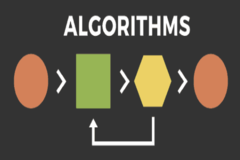
3190번: 뱀
'Dummy' 라는 도스게임이 있다. 이 게임에는 뱀이 나와서 기어다니는데, 사과를 먹으면 뱀 길이가 늘어난다. 뱀이 이리저리 기어다니다가 벽 또는 자기자신의 몸과 부딪히면 게임이 끝난다. 게임
www.acmicpc.net

풀이 과정
문제 설명
- 벽을 만나거나 뱀 자신에게 닿으면 종료
- 다음칸에 사과가 있다면 뱀의 길이를 늘린다.
- 뱀의 머리를 사과 있는 칸으로 머리를 이동
- 다음칸에 사과가 없다면 뱀의 길이를 늘리지 않는다.
- 뱀의 꼬리를 자르고 사과 있는 칸으로 머리를 이동
- 특정 시간에 VALUE가 D이면 머리를 우측으로 L이면 좌측으로 이동
- 머리 회전은 이동 후에 진행된다.
필자는 벽과 뱀이 지나간 자리를 모두 2로 설정하였고 다음칸이 2면 종료하도록 설정하였다.
또한 뱀의 꼬리와 머리를 각각의 상황별로 add 시키기 위해서 Deque를 사용하였다.
private static int[][] direction = {{0, -1}, {1, 0}, {0, 1}, {-1, 0}};처음 머리 진행방향은 1, 0 이므로 (1번째 인덱스)
D 이면 현재 진행 방향에서 + 1을 해서 4로 나는 나머지로 방향을 구했다.
L 이면 현재 진행 방향에서 + 3을 해서 4로 나눈 나머지로 방향을 구했다.
한 번씩 그려보면 이해가 빠를 것이다.
또한 다음 진행 방향을 map [nextX][nextY]로 한 것이 아닌 map [nextY][nextX]로 지정한 것이 특징이다.
사실 이 부분이 가장 이해가 안 되었다. 이유는 이동 방향을 좌표상으로 생각하였기 때문이다. 좌표가 아닌 행렬에서 이동하는 것인데 말이다.
소스 코드
import java.util.ArrayDeque;
import java.util.Deque;
import java.util.HashMap;
import java.util.Map;
import java.util.Scanner;
public class Snake {
private static int size;
private static int[][] map;
private static Map<Integer, String> rotation;
private static int[][] direction = {{0, -1}, {1, 0}, {0, 1}, {-1, 0}};
public static void main(String[] args) {
// TODO Auto-generated method stub
Scanner scanner = new Scanner(System.in);
size = scanner.nextInt();
map = new int[size+2][size+2];
// 벽은 2로 지정
for (int i = 0; i < size + 2; i++) {
map[0][i] = 2;
map[i][0] = 2;
map[i][size+1] = 2;
map[size+1][i] = 2;
}
// 사과 위치는 1로 지정
int appleSize = scanner.nextInt();
for (int i = 0; i < appleSize; i++) {
int appleX = scanner.nextInt();
int appleY = scanner.nextInt();
map[appleX][appleY] = 1;
}
// 회전 정보 지정
int whereSize = scanner.nextInt();
scanner.nextLine();
rotation = new HashMap<Integer, String>();
for (int i = 0; i < whereSize; i++) {
String[] str = scanner.nextLine().split(" ");
rotation.put(Integer.parseInt(str[0]), str[1]);
}
Deque<Point> snake = new ArrayDeque<>();
snake.addFirst(new Point(1, 1));
int where = 1;
int time = 1;
while(true) {
Point point = snake.peekLast();
int startX = point.getX();
int startY = point.getY();
int nextX = startX + direction[where][0];
int nextY = startY + direction[where][1];
// 벽에 부딪히거나 자신에게 닿으면 2
if (map[nextY][nextX] == 2) {
break;
}
//사과가 없는경우
if (map[nextY][nextX] != 1) {
Point tail = snake.pollFirst();
int tailX = tail.getX();
int tailY = tail.getY();
map[tailY][tailX] = 0;
}
map[nextY][nextX] = 2;
snake.addLast(new Point(nextY, nextX));
if(rotation.containsKey(time)) {
String direct = rotation.get(time);
where = direct.equals("D") ? (where + 1) % 4 : (where + 3) % 4;
}
time += 1;
}
System.out.println(time);
}
}
class Point {
private final int x;
private final int y;
public Point(int y, int x) {
super();
this.x = x;
this.y = y;
}
public int getX() {
return x;
}
public int getY() {
return y;
}
}'CS > Algorithm' 카테고리의 다른 글
| (알고리즘) 프로그래머스 - 오픈채팅방 (0) | 2020.11.04 |
|---|---|
| (알고리즘) boj - 치킨배달 (15686) (0) | 2020.11.04 |
| (알고리즘) N과 M (4) - 중복조합 (0) | 2020.10.21 |
| (알고리즘) N과 M (3) - 중복순열 (1) | 2020.10.21 |
| (알고리즘) N과 M (2) - 조합 (0) | 2020.10.21 |



